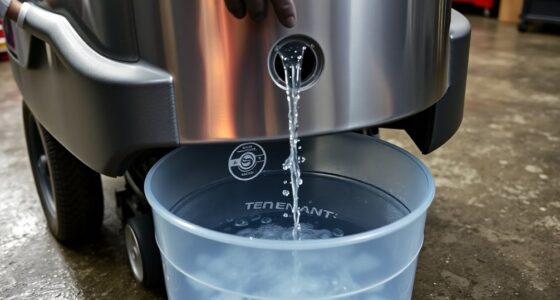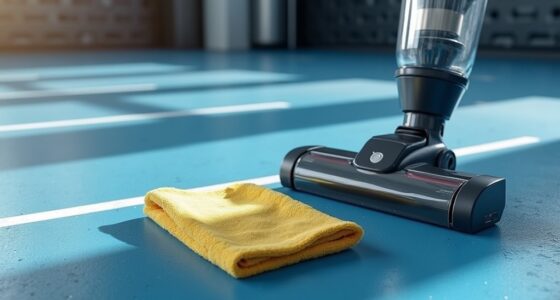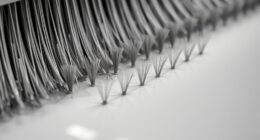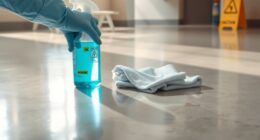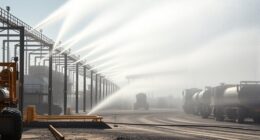To pick a quieter scrubber, you need to measure its noise levels accurately using a sound level meter in a controlled environment. Focus on the decibels at the source and compare these readings to safety standards like OSHA’s limit of 85 decibels for eight hours. Considering noise frequency also helps, as higher or lower pitch sounds can be more disturbing. If you want to learn how to optimize your choices and guarantee safety, there’s more to explore below.
Key Takeaways
- Use a calibrated sound level meter to accurately measure scrubber noise at ear level in a controlled environment.
- Record decibel levels at consistent distances to ensure comparable data across different scrubber models.
- Measure the noise output in settings similar to the intended installation environment to account for ambient noise.
- Compare measured decibel levels against OSHA or industry standards (e.g., 85 dB over 8 hours) to ensure safety compliance.
- Consider noise frequency alongside decibel levels, as higher frequencies are more disturbing even at lower volumes.

Understanding how loud a sound is can seem simple, but measuring its intensity requires precise tools and techniques. When evaluating a quieter scrubber business, it’s vital to understand how noise frequency and decibel standards influence the noise levels produced. Noise frequency refers to the pitch of the sound, measured in Hertz (Hz), and plays a critical role in how humans perceive noise. Higher frequencies, like squeals or hisses, can be more disturbing even at lower decibel levels, while lower frequencies, such as hums or rumbles, might seem less intrusive but can still cause discomfort over time. Recognizing this difference helps you select equipment that minimizes annoyance and health risks.
Decibel standards are the benchmarks used to categorize and regulate noise levels. In many industries, including cleaning and manufacturing, there are established limits to ensure worker safety and community comfort. For instance, OSHA (Occupational Safety and Health Administration) recommends a maximum exposure of 85 decibels over an 8-hour shift, but some standards vary depending on the context. When measuring noise from a scrubber, you need a precision instrument called a sound level meter, which quantifies the decibel level accurately. Regularly checking the decibel readings against these standards helps you compare different models and choose one that operates within safe limits, reducing the risk of hearing damage or noise complaints.
It’s also important to take into account the measurement environment because background noise can skew your results. Conduct measurements in a quiet, controlled setting to get an accurate reading of the scrubber’s noise output. Position the sound level meter at a consistent distance from the equipment—typically at ear level and a few feet away—to ensure reliable comparisons. Remember, the goal isn’t just to meet decibel standards but to opt for a scrubber that produces lower noise levels within those limits, especially if the device will be used in sensitive environments like hospitals or schools.
Frequently Asked Questions
How Do Different Scrubber Materials Affect Noise Levels?
Different scrubber materials impact noise levels based on their acoustic absorption and durability. You’ll notice softer, more porous materials absorb sound better, reducing noise. Conversely, harder, less absorptive materials might reflect sound, increasing noise levels. Material durability also matters, as long-lasting materials maintain their acoustic properties over time. Selecting the right combination of acoustic absorption and durability guarantees your scrubber operates quieter, creating a more comfortable work environment.
What Is the Optimal Decibel Range for Workplace Safety?
Did you know that prolonged exposure to noise levels above 85 decibels can cause hearing loss? For workplace safety, aim to keep noise pollution below this threshold. You should use hearing protection if noise levels reach 85 dB or higher. Maintaining decibel levels within the safe range assists in preventing hearing damage and ensures a healthier work environment, protecting your ears and improving overall safety.
How Often Should Noise Levels Be Re-Measured?
You should re-measure noise levels regularly, ideally every six months or whenever there are significant changes in equipment or processes. Use reliable noise measurement techniques and verify decibel calibration is done before each measurement to maintain accuracy. Frequent re-measurements help you identify rising noise levels early, allowing you to implement necessary controls and protect worker hearing. Consistent monitoring keeps your workplace safe and compliant with regulations.
Can Noise Reduction Impact Scrubber Performance?
Your noise reduction efforts can dramatically enhance scrubber performance, almost like turning down a thunderstorm to a gentle rain. By installing acoustic insulation and soundproof barriers, you minimize noise impact, helping the scrubber operate more efficiently without distractions. Reduced noise levels can prevent equipment strain and improve maintenance intervals. So, yes, noise reduction not only creates a quieter environment but also boosts your scrubber’s overall effectiveness and longevity.
Are There Regulations for Acceptable Noise Levels in Manufacturing?
You should know that regulations for acceptable noise levels in manufacturing aim to limit noise pollution, protecting workers and nearby communities. Acoustic engineering plays a key role in designing equipment that complies with these standards. While regulations vary by region, they generally specify maximum decibel levels to ensure safety. Staying informed about local laws helps you select machinery that minimizes noise pollution, promotes safety, and adheres to legal requirements.
Conclusion
By understanding decibels, you hold the key to silence amidst chaos. Think of sound levels as a compass guiding you through noise, helping you find the quieter path. Choosing the right scrubber isn’t just about numbers—it’s about reclaiming your peace. When you measure wisely, you’re not just reducing noise; you’re planting seeds of calm in your environment. Embrace the science, and let silence become your guiding star.



